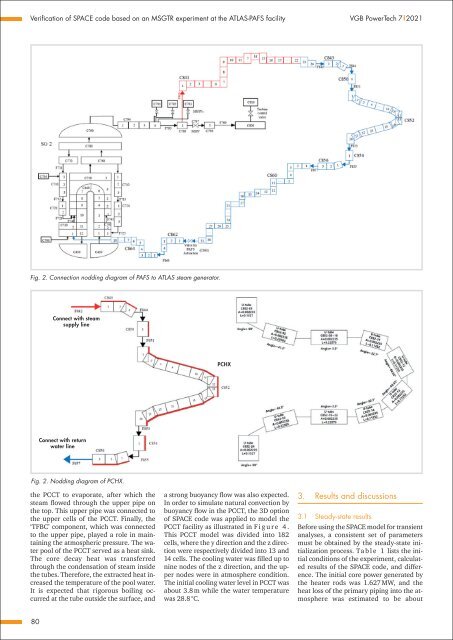VGB POWERTECH 7 (2021) - International Journal for Generation and Storage of Electricity and Heat
VGB PowerTech - International Journal for Generation and Storage of Electricity and Heat. Issue 7 (2021). Technical Journal of the VGB PowerTech Association. Energy is us! Optimisation of power plants. Thermal waste utilisation.
VGB PowerTech - International Journal for Generation and Storage of Electricity and Heat. Issue 7 (2021).
Technical Journal of the VGB PowerTech Association. Energy is us!
Optimisation of power plants. Thermal waste utilisation.
- No tags were found...
Create successful ePaper yourself
Turn your PDF publications into a flip-book with our unique Google optimized e-Paper software.
Verification <strong>of</strong> SPACE code based on an MSGTR experiment at the ATLAS-PAFS facility <strong>VGB</strong> PowerTech 7 l <strong>2021</strong><br />
Fig. 2. Connection nodding diagram <strong>of</strong> PAFS to ATLAS steam generator.<br />
Connect with steam<br />
supply line<br />
PCHX<br />
Connect with return<br />
water line<br />
Fig. 2. Nodding diagram <strong>of</strong> PCHX.<br />
the PCCT to evaporate, after which the<br />
steam flowed through the upper pipe on<br />
the top. This upper pipe was connected to<br />
the upper cells <strong>of</strong> the PCCT. Finally, the<br />
‘TFBC’ component, which was connected<br />
to the upper pipe, played a role in maintaining<br />
the atmospheric pressure. The water<br />
pool <strong>of</strong> the PCCT served as a heat sink.<br />
The core decay heat was transferred<br />
through the condensation <strong>of</strong> steam inside<br />
the tubes. There<strong>for</strong>e, the extracted heat increased<br />
the temperature <strong>of</strong> the pool water.<br />
It is expected that rigorous boiling occurred<br />
at the tube outside the surface, <strong>and</strong><br />
a strong buoyancy flow was also expected.<br />
In order to simulate natural convection by<br />
buoyancy flow in the PCCT, the 3D option<br />
<strong>of</strong> SPACE code was applied to model the<br />
PCCT facility as illustrated in F i g u r e 4 .<br />
This PCCT model was divided into 182<br />
cells, where the y direction <strong>and</strong> the z direction<br />
were respectively divided into 13 <strong>and</strong><br />
14 cells. The cooling water was filled up to<br />
nine nodes <strong>of</strong> the z direction, <strong>and</strong> the upper<br />
nodes were in atmosphere condition.<br />
The initial cooling water level in PCCT was<br />
about 3.8 m while the water temperature<br />
was 28.8 °C.<br />
3. Results <strong>and</strong> discussions<br />
3.1 Steady-state results<br />
Be<strong>for</strong>e using the SPACE model <strong>for</strong> transient<br />
analyses, a consistent set <strong>of</strong> parameters<br />
must be obtained by the steady-state initialization<br />
process. Ta b l e 1 lists the initial<br />
conditions <strong>of</strong> the experiment, calculated<br />
results <strong>of</strong> the SPACE code, <strong>and</strong> difference.<br />
The initial core power generated by<br />
the heater rods was 1.627 MW, <strong>and</strong> the<br />
heat loss <strong>of</strong> the primary piping into the atmosphere<br />
was estimated to be about<br />
80


















